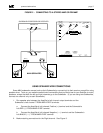
page 11powered subwoofers
If you already own a K-10 and would like to upgrade your subwoofer performance, you don't need to trade
your subwoofer in for a new model. The K-11 upgrade path will give you the full benefit of a push-pull dual-driver
subwoofer, with its even-order harmonic distortion cancellation and higher output capability.
10. HOME THEATRE USAGE
If you are using your Subwoofer in a multichannel Home Theatre system, make sure you are using the
Subwoofer Output jack to connect your subwoofer. Check "Use of the Bypass Switch" above, as well as M&K's
System Setup Guide on page 13.
Compared to music sources, in some cases, you may prefer the subwoofer set to a higher playback level
for video sources. This may occur when video sources (especially older films and some television) have very
little deep bass present. You may also want to exaggerate the effect to make spectacular video sources even
more impressive!
When your subwoofer is going to be located close to a television set, remember to leave 2 - 3 feet of
clearance between the television and subwoofer, unless the subwoofer is magnetically shielded.
CONNECTING THE SUBWOOFER TO A SURROUND
SOUND RECEIVER OR PROCESSOR:
The preferred connection from a surround sound amp or controller is from a SUBWOOFER OUTPUT (or
MONO) RCA jack. This connection insures that a full bass signal is fed to the subwoofer. If your component
doesn't have a subwoofer output jack, connect the Subwoofer to the front Left and Right channel speaker outputs
(do not use the Center channel speaker output).
VERY IMPORTANT: When the Subwoofer is connected to the Left and Right amplifier outputs using
speaker wires, the Center channel WIDE/NORMAL switch MUST be set to the NORMAL mode. If the switch
is set to the WIDE mode, the bass content of the Center channel will not be fed to the Subwoofer, and a significant
amount of the bass in the material you are listening to will be lost.
11. TROUBLESHOOTING
Your M&K Subwoofer amplifier circuit provides high reliability, and, if necessary, easy modular replace-
ment of parts. This guide will help you to solve or diagnose most problems that can occur with your Subwoofer.
In the event that a fuse blows, you must replace it with a fuse of the correct value to avoid a fire hazard and to
maintain your warranty protection.
1. If your Subwoofer has no output:
a. Make sure that the Subwoofer is plugged into an AC outlet.
b. Check the "BASS LEVEL" control and make sure that it is set above the "MIN" position. Rotate
it clockwise if it is set to the "MIN" position.
c. Check the red LED on the Subwoofer's back panel. If the LED is not lit, check the AC fuse next
to the LED. Unplug the Subwoofer before changing the fuse. See instructions on Page 12.
If the element inside the fuse is broken, replace the fuse. If it blows again, contact your dealer
or M&K.
d. If the red LED is lit, try this test: Turn the "BASS LEVEL" control to "MIN". Plug a standard RCA
cable into the "FROM PREAMP" jacks. Lightly touch the plug at the free end of the cable, while
slowly turning the "BASS LEVEL" control clockwise. If you hear noise from the Subwoofer when
you touch the cable, the Subwoofer is functioning. Look elsewhere in your system for the
problem. If you hear no noise, contact your dealer or M&K.


















